Analysis of TUFS Investment: Case Study for Northern Insurance
VerifiedAdded on 2021/06/17
|5
|1213
|66
Case Study
AI Summary
This case study examines the implementation of the Technical Underwriter Finance System (TUFS) at Northern Insurance, highlighting issues related to inadequate business involvement during the project's development and implementation. The analysis explores the project's initial goals, the challenges encountered, and the reasons for the system's failure to meet company standards. The document details the importance of business participation, outlining recommendations for future projects to ensure success, including the need for a strong relationship between business and technical teams, comprehensive documentation, and ongoing support throughout the production and deployment phases. It also addresses how Northern Insurance can realize the projected benefits of TUFS by maximizing system utilization, identifying and resolving problems through active use, and providing proper training. The study concludes by emphasizing the importance of collaboration between stakeholders, project management, and technical and business teams for efficient IT application production.
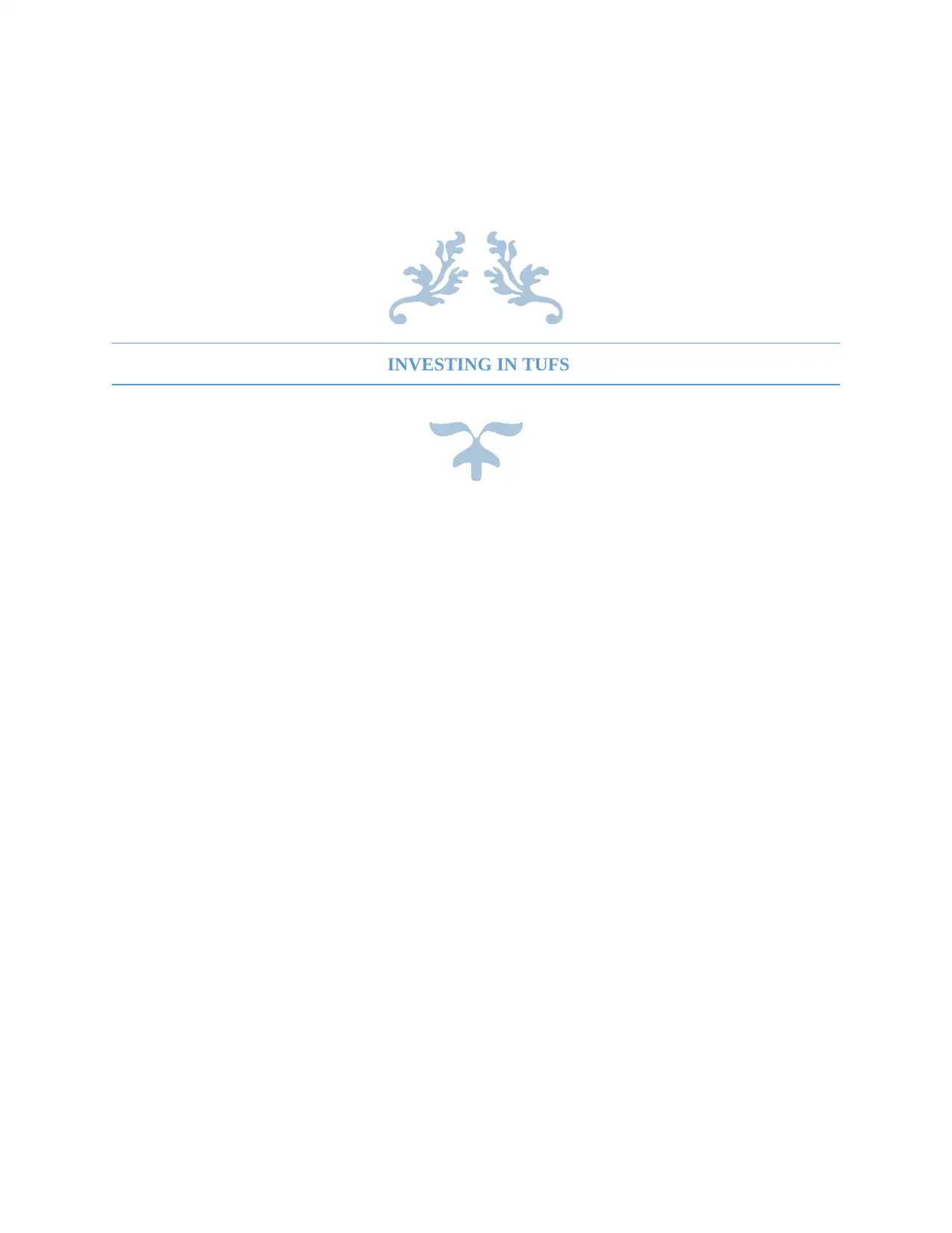
INVESTING IN TUFS
Paraphrase This Document
Need a fresh take? Get an instant paraphrase of this document with our AI Paraphraser
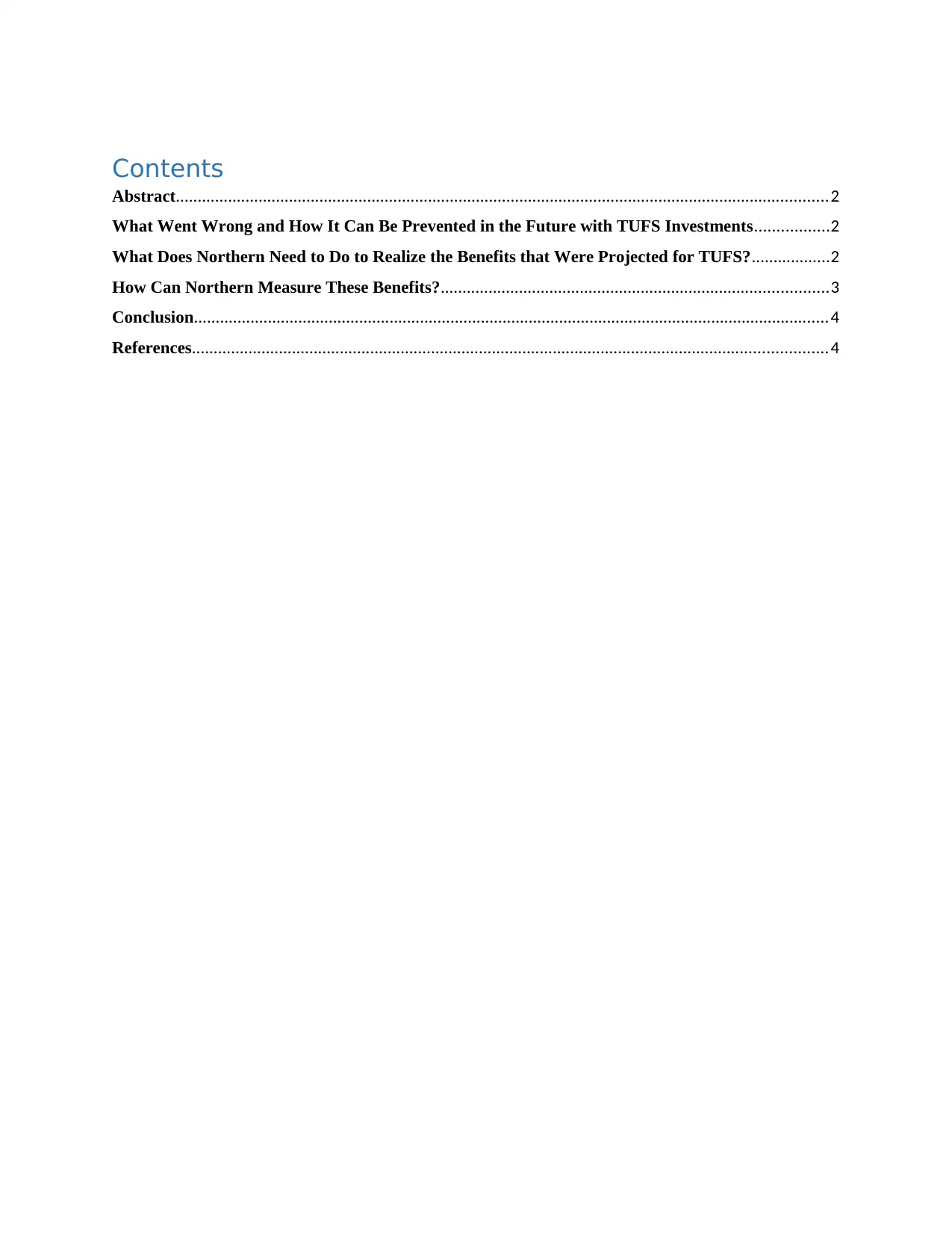
Contents
Abstract......................................................................................................................................................2
What Went Wrong and How It Can Be Prevented in the Future with TUFS Investments.................2
What Does Northern Need to Do to Realize the Benefits that Were Projected for TUFS?..................2
How Can Northern Measure These Benefits?.........................................................................................3
Conclusion..................................................................................................................................................4
References..................................................................................................................................................4
Abstract......................................................................................................................................................2
What Went Wrong and How It Can Be Prevented in the Future with TUFS Investments.................2
What Does Northern Need to Do to Realize the Benefits that Were Projected for TUFS?..................2
How Can Northern Measure These Benefits?.........................................................................................3
Conclusion..................................................................................................................................................4
References..................................................................................................................................................4
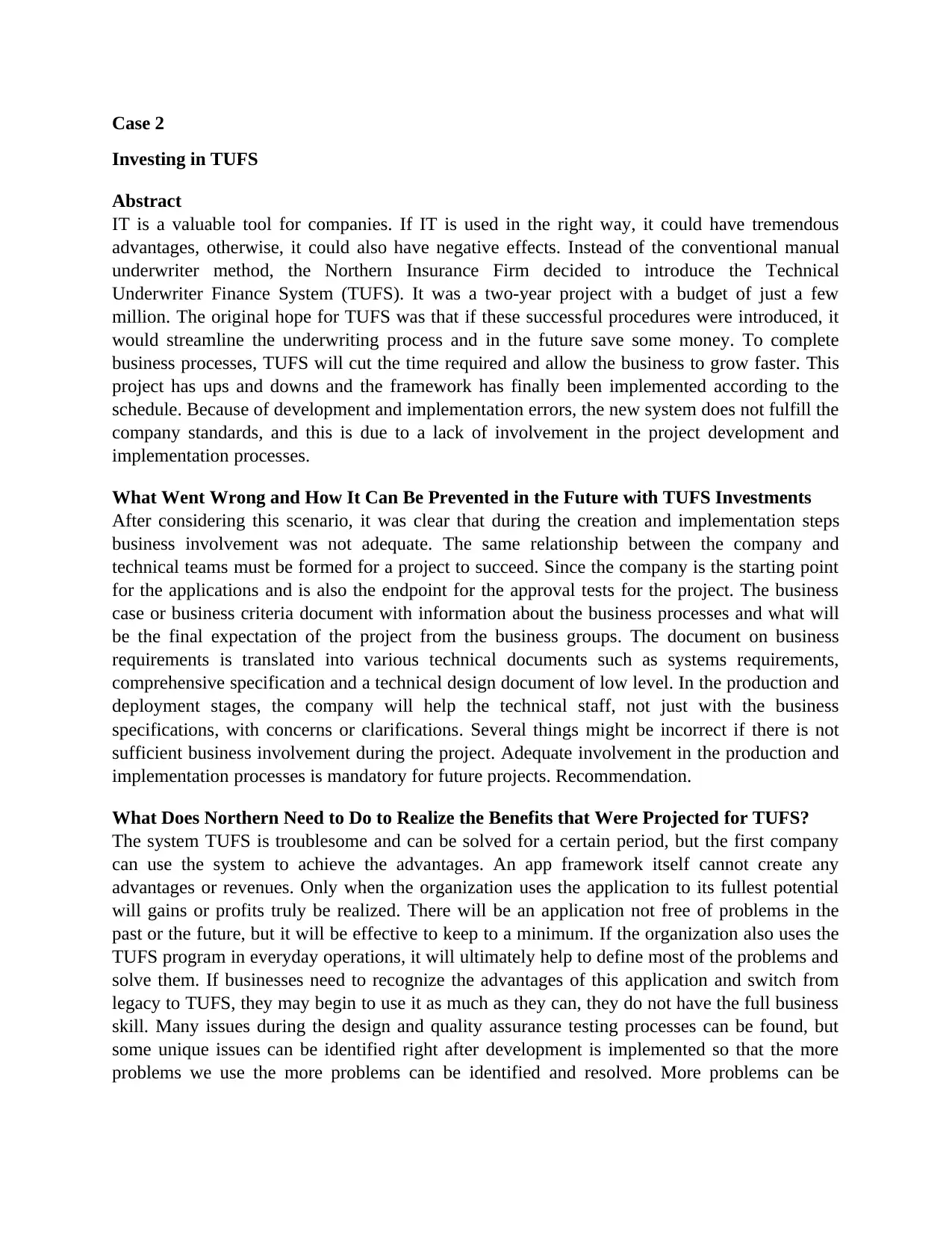
Case 2
Investing in TUFS
Abstract
IT is a valuable tool for companies. If IT is used in the right way, it could have tremendous
advantages, otherwise, it could also have negative effects. Instead of the conventional manual
underwriter method, the Northern Insurance Firm decided to introduce the Technical
Underwriter Finance System (TUFS). It was a two-year project with a budget of just a few
million. The original hope for TUFS was that if these successful procedures were introduced, it
would streamline the underwriting process and in the future save some money. To complete
business processes, TUFS will cut the time required and allow the business to grow faster. This
project has ups and downs and the framework has finally been implemented according to the
schedule. Because of development and implementation errors, the new system does not fulfill the
company standards, and this is due to a lack of involvement in the project development and
implementation processes.
What Went Wrong and How It Can Be Prevented in the Future with TUFS Investments
After considering this scenario, it was clear that during the creation and implementation steps
business involvement was not adequate. The same relationship between the company and
technical teams must be formed for a project to succeed. Since the company is the starting point
for the applications and is also the endpoint for the approval tests for the project. The business
case or business criteria document with information about the business processes and what will
be the final expectation of the project from the business groups. The document on business
requirements is translated into various technical documents such as systems requirements,
comprehensive specification and a technical design document of low level. In the production and
deployment stages, the company will help the technical staff, not just with the business
specifications, with concerns or clarifications. Several things might be incorrect if there is not
sufficient business involvement during the project. Adequate involvement in the production and
implementation processes is mandatory for future projects. Recommendation.
What Does Northern Need to Do to Realize the Benefits that Were Projected for TUFS?
The system TUFS is troublesome and can be solved for a certain period, but the first company
can use the system to achieve the advantages. An app framework itself cannot create any
advantages or revenues. Only when the organization uses the application to its fullest potential
will gains or profits truly be realized. There will be an application not free of problems in the
past or the future, but it will be effective to keep to a minimum. If the organization also uses the
TUFS program in everyday operations, it will ultimately help to define most of the problems and
solve them. If businesses need to recognize the advantages of this application and switch from
legacy to TUFS, they may begin to use it as much as they can, they do not have the full business
skill. Many issues during the design and quality assurance testing processes can be found, but
some unique issues can be identified right after development is implemented so that the more
problems we use the more problems can be identified and resolved. More problems can be
Investing in TUFS
Abstract
IT is a valuable tool for companies. If IT is used in the right way, it could have tremendous
advantages, otherwise, it could also have negative effects. Instead of the conventional manual
underwriter method, the Northern Insurance Firm decided to introduce the Technical
Underwriter Finance System (TUFS). It was a two-year project with a budget of just a few
million. The original hope for TUFS was that if these successful procedures were introduced, it
would streamline the underwriting process and in the future save some money. To complete
business processes, TUFS will cut the time required and allow the business to grow faster. This
project has ups and downs and the framework has finally been implemented according to the
schedule. Because of development and implementation errors, the new system does not fulfill the
company standards, and this is due to a lack of involvement in the project development and
implementation processes.
What Went Wrong and How It Can Be Prevented in the Future with TUFS Investments
After considering this scenario, it was clear that during the creation and implementation steps
business involvement was not adequate. The same relationship between the company and
technical teams must be formed for a project to succeed. Since the company is the starting point
for the applications and is also the endpoint for the approval tests for the project. The business
case or business criteria document with information about the business processes and what will
be the final expectation of the project from the business groups. The document on business
requirements is translated into various technical documents such as systems requirements,
comprehensive specification and a technical design document of low level. In the production and
deployment stages, the company will help the technical staff, not just with the business
specifications, with concerns or clarifications. Several things might be incorrect if there is not
sufficient business involvement during the project. Adequate involvement in the production and
implementation processes is mandatory for future projects. Recommendation.
What Does Northern Need to Do to Realize the Benefits that Were Projected for TUFS?
The system TUFS is troublesome and can be solved for a certain period, but the first company
can use the system to achieve the advantages. An app framework itself cannot create any
advantages or revenues. Only when the organization uses the application to its fullest potential
will gains or profits truly be realized. There will be an application not free of problems in the
past or the future, but it will be effective to keep to a minimum. If the organization also uses the
TUFS program in everyday operations, it will ultimately help to define most of the problems and
solve them. If businesses need to recognize the advantages of this application and switch from
legacy to TUFS, they may begin to use it as much as they can, they do not have the full business
skill. Many issues during the design and quality assurance testing processes can be found, but
some unique issues can be identified right after development is implemented so that the more
problems we use the more problems can be identified and resolved. More problems can be
⊘ This is a preview!⊘
Do you want full access?
Subscribe today to unlock all pages.

Trusted by 1+ million students worldwide
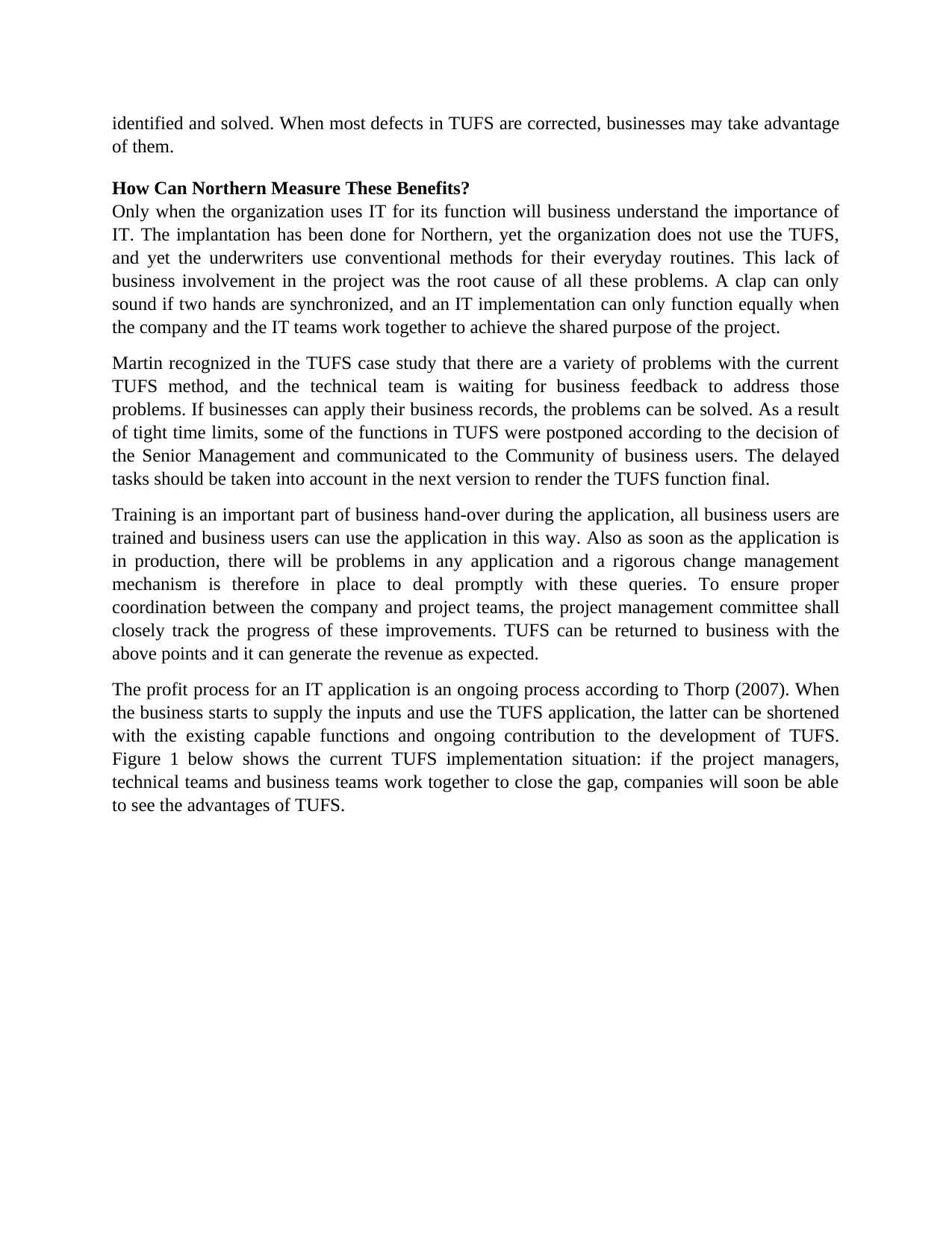
identified and solved. When most defects in TUFS are corrected, businesses may take advantage
of them.
How Can Northern Measure These Benefits?
Only when the organization uses IT for its function will business understand the importance of
IT. The implantation has been done for Northern, yet the organization does not use the TUFS,
and yet the underwriters use conventional methods for their everyday routines. This lack of
business involvement in the project was the root cause of all these problems. A clap can only
sound if two hands are synchronized, and an IT implementation can only function equally when
the company and the IT teams work together to achieve the shared purpose of the project.
Martin recognized in the TUFS case study that there are a variety of problems with the current
TUFS method, and the technical team is waiting for business feedback to address those
problems. If businesses can apply their business records, the problems can be solved. As a result
of tight time limits, some of the functions in TUFS were postponed according to the decision of
the Senior Management and communicated to the Community of business users. The delayed
tasks should be taken into account in the next version to render the TUFS function final.
Training is an important part of business hand-over during the application, all business users are
trained and business users can use the application in this way. Also as soon as the application is
in production, there will be problems in any application and a rigorous change management
mechanism is therefore in place to deal promptly with these queries. To ensure proper
coordination between the company and project teams, the project management committee shall
closely track the progress of these improvements. TUFS can be returned to business with the
above points and it can generate the revenue as expected.
The profit process for an IT application is an ongoing process according to Thorp (2007). When
the business starts to supply the inputs and use the TUFS application, the latter can be shortened
with the existing capable functions and ongoing contribution to the development of TUFS.
Figure 1 below shows the current TUFS implementation situation: if the project managers,
technical teams and business teams work together to close the gap, companies will soon be able
to see the advantages of TUFS.
of them.
How Can Northern Measure These Benefits?
Only when the organization uses IT for its function will business understand the importance of
IT. The implantation has been done for Northern, yet the organization does not use the TUFS,
and yet the underwriters use conventional methods for their everyday routines. This lack of
business involvement in the project was the root cause of all these problems. A clap can only
sound if two hands are synchronized, and an IT implementation can only function equally when
the company and the IT teams work together to achieve the shared purpose of the project.
Martin recognized in the TUFS case study that there are a variety of problems with the current
TUFS method, and the technical team is waiting for business feedback to address those
problems. If businesses can apply their business records, the problems can be solved. As a result
of tight time limits, some of the functions in TUFS were postponed according to the decision of
the Senior Management and communicated to the Community of business users. The delayed
tasks should be taken into account in the next version to render the TUFS function final.
Training is an important part of business hand-over during the application, all business users are
trained and business users can use the application in this way. Also as soon as the application is
in production, there will be problems in any application and a rigorous change management
mechanism is therefore in place to deal promptly with these queries. To ensure proper
coordination between the company and project teams, the project management committee shall
closely track the progress of these improvements. TUFS can be returned to business with the
above points and it can generate the revenue as expected.
The profit process for an IT application is an ongoing process according to Thorp (2007). When
the business starts to supply the inputs and use the TUFS application, the latter can be shortened
with the existing capable functions and ongoing contribution to the development of TUFS.
Figure 1 below shows the current TUFS implementation situation: if the project managers,
technical teams and business teams work together to close the gap, companies will soon be able
to see the advantages of TUFS.
Paraphrase This Document
Need a fresh take? Get an instant paraphrase of this document with our AI Paraphraser
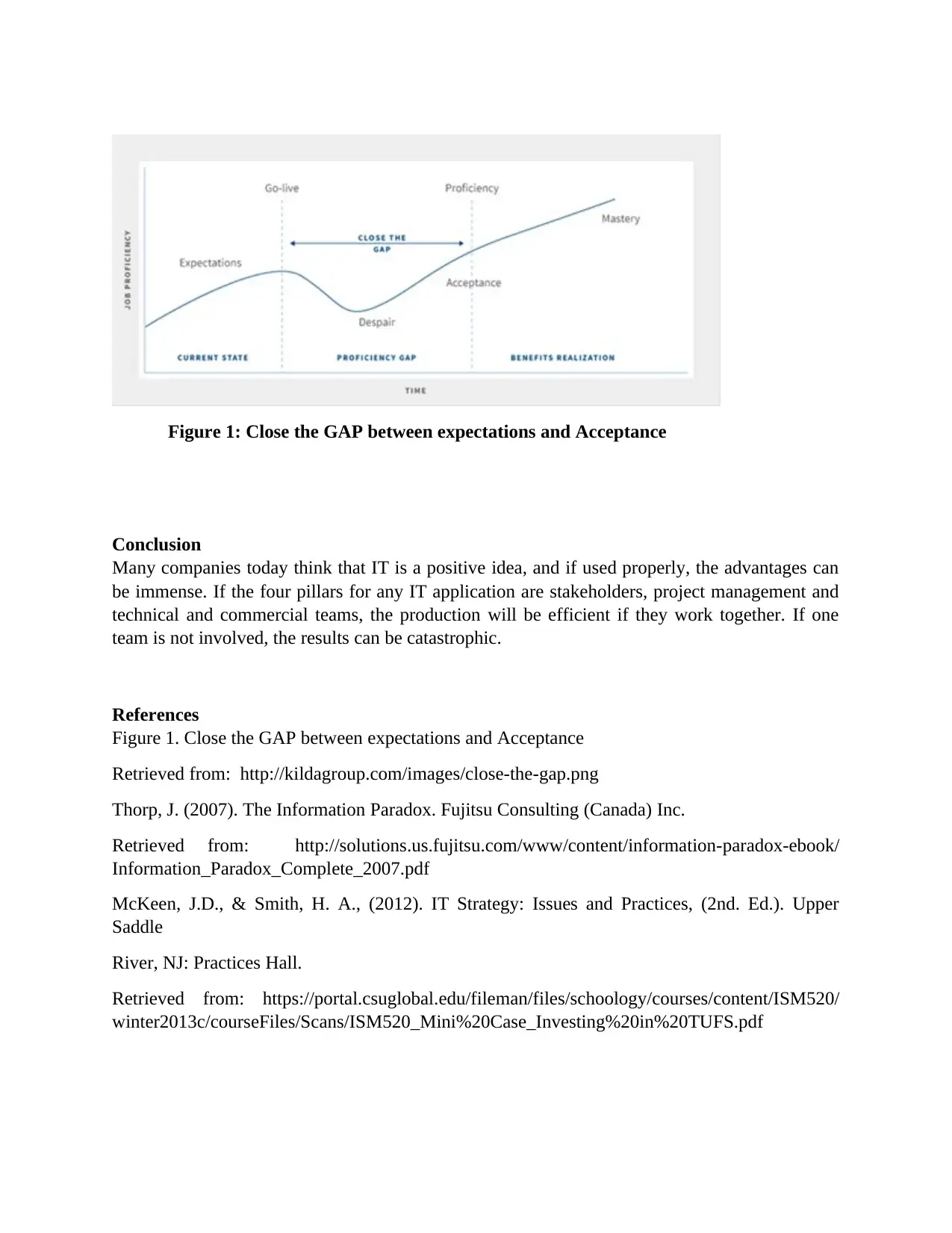
Figure 1: Close the GAP between expectations and Acceptance
Conclusion
Many companies today think that IT is a positive idea, and if used properly, the advantages can
be immense. If the four pillars for any IT application are stakeholders, project management and
technical and commercial teams, the production will be efficient if they work together. If one
team is not involved, the results can be catastrophic.
References
Figure 1. Close the GAP between expectations and Acceptance
Retrieved from: http://kildagroup.com/images/close-the-gap.png
Thorp, J. (2007). The Information Paradox. Fujitsu Consulting (Canada) Inc.
Retrieved from: http://solutions.us.fujitsu.com/www/content/information-paradox-ebook/
Information_Paradox_Complete_2007.pdf
McKeen, J.D., & Smith, H. A., (2012). IT Strategy: Issues and Practices, (2nd. Ed.). Upper
Saddle
River, NJ: Practices Hall.
Retrieved from: https://portal.csuglobal.edu/fileman/files/schoology/courses/content/ISM520/
winter2013c/courseFiles/Scans/ISM520_Mini%20Case_Investing%20in%20TUFS.pdf
Conclusion
Many companies today think that IT is a positive idea, and if used properly, the advantages can
be immense. If the four pillars for any IT application are stakeholders, project management and
technical and commercial teams, the production will be efficient if they work together. If one
team is not involved, the results can be catastrophic.
References
Figure 1. Close the GAP between expectations and Acceptance
Retrieved from: http://kildagroup.com/images/close-the-gap.png
Thorp, J. (2007). The Information Paradox. Fujitsu Consulting (Canada) Inc.
Retrieved from: http://solutions.us.fujitsu.com/www/content/information-paradox-ebook/
Information_Paradox_Complete_2007.pdf
McKeen, J.D., & Smith, H. A., (2012). IT Strategy: Issues and Practices, (2nd. Ed.). Upper
Saddle
River, NJ: Practices Hall.
Retrieved from: https://portal.csuglobal.edu/fileman/files/schoology/courses/content/ISM520/
winter2013c/courseFiles/Scans/ISM520_Mini%20Case_Investing%20in%20TUFS.pdf
1 out of 5
Related Documents
Your All-in-One AI-Powered Toolkit for Academic Success.
+13062052269
info@desklib.com
Available 24*7 on WhatsApp / Email
![[object Object]](/_next/static/media/star-bottom.7253800d.svg)
Unlock your academic potential
Copyright © 2020–2025 A2Z Services. All Rights Reserved. Developed and managed by ZUCOL.




